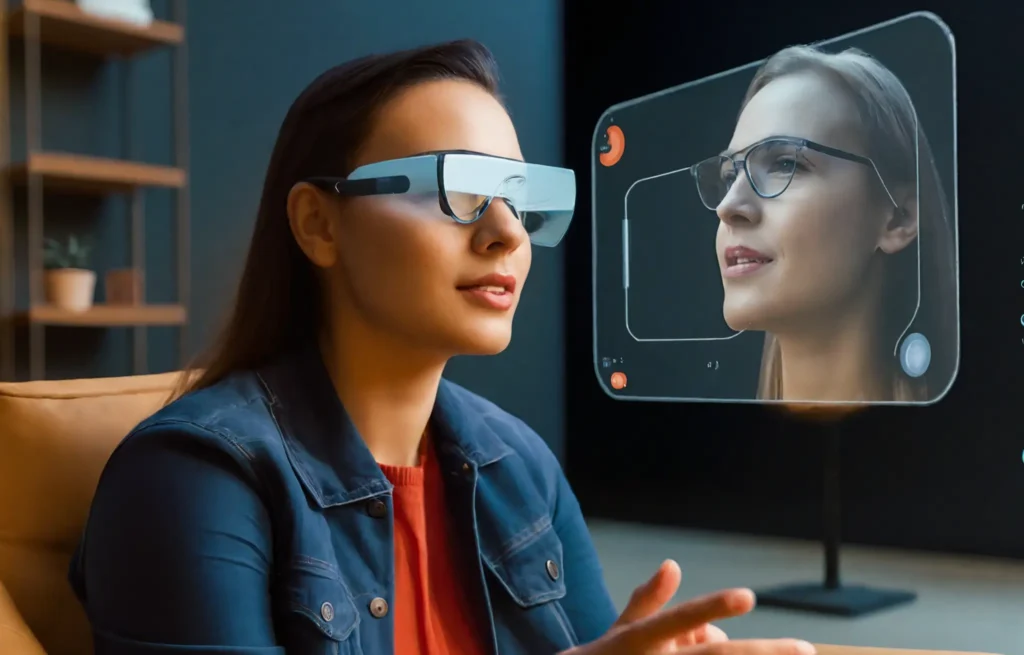
A few days ago, Mark Zuckerberg unveiled a prototype of Meta’s new augmented reality (AR) glasses at a Meta Connect 2024 event. By projecting 2D and 3D content into the real world, Orion is the “most advanced AR glasses ever made,” he says. Its goal is to bridge the gap between the real and virtual worlds. In contrast to other devices, Orion enables interaction through hand gestures, vocal instructions, and a neural interface that converts brain signals into digital commands using a wristband. This makes it possible to operate devices hands-free, such as modifying digital calendars and holding video chats without pulling out a smartphone.
Table of Contents
Orion: Lightweight AR Glasses with AI-Powered Holographic Display and Contextual Assistance
A distinctive feature of Orion is its lightweight design, weighing less than 100 grams, which makes it more comfortable and portable than heavier AR headsets. With the device’s tremendous holographic display, you can see immersive content in front of you, such as life-size holograms and multitasking windows. Orion is driven by Meta’s artificial intelligence (AI), which improves augmented reality (AR) by recognizing the environment and providing contextual help, including recipe recommendations based on refrigerator contents or message sending without a smartphone.
Meta’s Orion AR Glasses: Paving the Way for Smart Glasses as the Future of Personal Computing
This advancement highlights Meta’s objective to use AR glasses as the main platform for personal computing in place of smartphones, advancing the possibility that smart glasses may eventually be able to do all phone operations. AR glasses are quickly becoming the next big thing in a world where technology is getting more and more integrated into our daily lives. By seamlessly integrating cutting-edge artificial intelligence (AI) with augmented reality to produce an immersive experience, the Orion prototype AR glasses mark a significant advancement. What makes AR glasses important, though? And what distinguishes them in today’s tech world?

Why Augmented Reality Glasses?
AR glasses provide a revolutionary way to perceive the digital world; they are more than simply a tech toy. Here’s why they’re gaining so much attention:
1. Expanding Digital Experiences Beyond Screens:
Unlike smartphones, which limit users to small screens, augmented reality glasses provide large holographic displays. This makes the real world an interactive canvas by enabling users to position 2D and 3D material anywhere in their environment. AR glasses can be used for work, entertainment or education and they allow a level of engagement and interaction not possible with traditional technologies.
2. Contextual AI for Smooth Communication
In addition to displaying material, Orion AR glasses have sophisticated contextual AI built in that can detect and comprehend your surroundings. The glasses can anticipate user needs and proactively deliver pertinent information or ideas, whether for work, entertainment, or navigation, by processing real-time data.
3. Lightweight and flexible Design
Comfort and usability have always been issues with wearable technology. Here, the Orion prototype excels since it has a lightweight design that can be used for both indoors and outdoors. Notably, because they don’t mask facial characteristics or expressions, these smart glasses enable users to maintain natural eye contact, in contrast to many earlier versions.

Smart Glasses in 2024
Smart glasses have come a long way since their inception, and in 2024, they have become wearable technology with a combination of multimedia, augmented reality, and artificial intelligence. Some models, like Orion, concentrate on augmented reality-driven experiences, while others give priority to fitness tracking or notifications. Holographic displays, voice interaction, AI-driven contextual awareness, and seamless device integration are now the main characteristics of smart glasses.
How Do AI Glasses Work?
Artificial intelligence is a key component of AR wearables, as illustrated by glasses with AI capabilities like Envision Glasses. These devices have cameras that scan everything in their immediate environment, including text, people and objects. After processing this data, the glasses transmit the results back to the wearer using either built-in speakers or Bluetooth-enabled earphones. Users can experience enhanced, real-time information with this AI and AR combination without losing attention on the outside world.
The Future of AR Glasses

The Orion prototype is a promising step toward the widespread use of AR glasses. Orion has the potential to completely change how humans interact with both the digital and physical worlds by integrating AI and AR. The potential uses are numerous, ranging from transforming entertainment and education to improving productivity using contextual information.
To sum up, augmented reality glasses—especially the Orion prototypes—are laying the foundation for a time when digital experiences won’t be limited to handheld devices. With cutting-edge features like AI integration and lightweight design, they are going to revolutionize the way we live, work, and connect.
